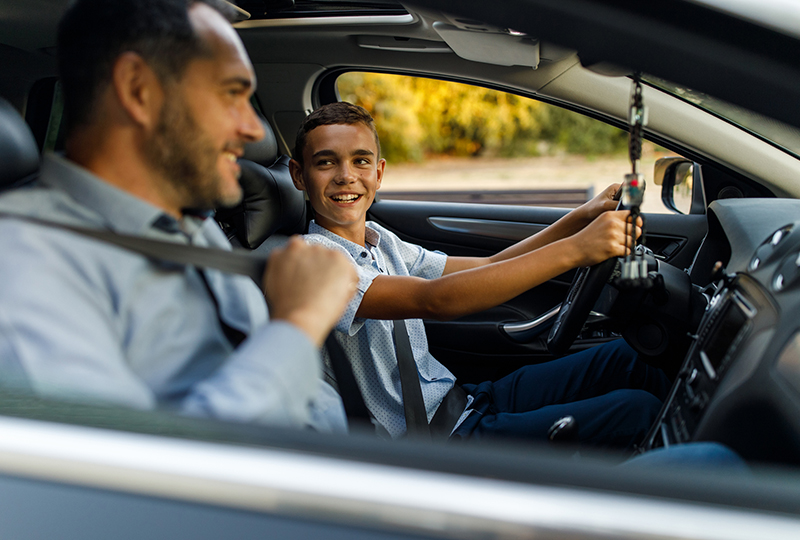Build skills slowly. No yelling. Breathe. Here’s how to teach a teenager to drive.
It took my son more than a year to get his learner’s permit, and after he finally overcame his reluctance to learn to drive, we spent lots of time making shaky loops around empty parking lots.
Teaching your teen to drive will probably be stressful. The thought of children behind the wheel has struck terror into parents’ hearts ever since there have been cars. (Did Pa Ingalls lose sleep over Laura learning to handle a horse and wagon?) Being a safe, responsible driver is a life skill that teens must master, however. Here are my tips for teaching a teenager to drive without losing your sanity.
1. Start in an empty parking lot and build skills gradually.
In case it’s not obvious, teaching a teenager to drive requires a lot of safe space – physical and psychological – for practice, especially the first few times behind the wheel. He may misjudge how soon to start a turn, or confuse the gas pedal for the brake. My kid did. So you don’t want those early lessons where there is any traffic – or curbs, trees, fences or people.
If your teen is very anxious about driving, he may need a lot of time (days or weeks) rolling sloooooowly through empty space, getting a feel for the car before gaining confidence to cruise a public street. Or maybe even a few sessions just sitting behind the wheel, racing the engine while still in park, or keeping a foot on the brake while shifting through the gears, just to get a feel for things before actually moving. Start as basic as necessary for your kid’s comfort level and work up from there.
2. Practice often.
My husband took our son out driving twice in the week after he gained his permit. Then we got busy with other things. No practice for a month. When we got back to it, our son had to get accustomed all over again to signaling and simple turns. Lesson learned: Make practice as frequent as possible. Once we began taking him out several times a week, he picked things up much faster.
3. Two (or more) teachers are better than one.
I learned to drive from my mother. Dad had nothing to do with it. My husband and I see driving lessons as a joint responsibility, though, and our son benefitted from this.
For example, he struggled with parking. My husband postponed working on that, thinking our teen should get comfortable driving in straight lines and big turns first. But I made him practice parking constantly. I set up a stack of plastic storage bins to mark off parking spaces; that gave him big visible objects (but not valuable ones!) to aim around.
Son had trouble staying centered in his driving lane, so I only let him practice on the quietest suburban streets, with wide shoulders and few turns, fearing he’d drift onto a shoulder or into oncoming traffic. But my husband came home after a driving session, announcing that he let our kid drive 16 miles round-trip, on narrow, curvy two-lane country roads. The thought gave me shudders, but our teen was super proud.
My husband and I disagreed about strategy, but our son got variety in his practice and a balance of skills.
Another option is a driving school, though we didn’t go this route. If Son got stuck on a particular skill — parallel parking? — we would have considered a professional instructor.
4. Keep emotions in check.
If there’s yelling, swearing, whining or tears (your kid’s, or yours), it’s time to give up for the day and just go home. A new driver can’t focus safely when angry, overwhelmed or jumpy. Ditto for Mom or Dad’s ability to give calm, constructive feedback. If driving lessons frequently get overheated, let the other parent try next time, or enlist another (level-headed) relative or trusted friend. Or resort to the driving school. That takes family dynamics out of the equation.
Also, it’s important to talk with teens about the risks of reckless or distracted driving, and your family’s rules for using the car. But it’s better to have these chats at home, not when the teen is behind the wheel.
5. Expect “oops” moments.
Your teen will bump the curb, confuse the windshield wipers for the turn signal or lurch forward in the wrong gear. (You’re both buckled in, right?)
As long as you’re not putting him in situations truly over his head, accept that practice won’t be perfect. Make sure your teen is comfortable with the most basic tasks, like coming to a stop, before more challenging ones, like backing up. My new mantra: “It’s okay. Try again.”
We logged many hours of practice before our son performed the basics smoothly enough that it felt safe to guide him on the highway, in traffic, in the dark or bad weather. His job: practicing steering. Mine: practicing Zen.
This post was written by Maura Ammenheuser, a communications specialist in Vanderbilt Health’s Marketing & Engagement Department. She is the mother of two grown children who are confident, licensed drivers.

